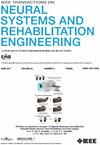Muscle Spindle Model-Based Non-Invasive Electrical Stimulation for Motion Perception Feedback in Prosthetic Hands
IF 4.8
2区 医学
Q2 ENGINEERING, BIOMEDICAL
IEEE Transactions on Neural Systems and Rehabilitation Engineering
Pub Date : 2025-04-01
DOI:10.1109/TNSRE.2025.3556726
引用次数: 0
Abstract
Prosthetic hands offer significant benefits for patients with hand amputations by partially replicating the function of real hands. However, most current prosthetics lack sensory feedback on movement, leading to a gap in proprioception for users. To bridge this gap and approximate the natural experience of hand use, prosthetic hands must offer detailed motion feedback. This paper introduces a non-invasive electrical stimulation approach, which can provide motion perception feedback through modeling muscle spindles. By employing transcutaneous electrical nerve stimulation (TENS), the method generates artificial sensory signals associated with the movement of a prosthetic hand, potentially restoring a degree of proprioception for patients with hand amputations. We developed an experimental framework involving an electronic prosthetic hand, an electrical stimulator, and surface electrodes to assess our approach. Five able-body and three forearm amputees took part in our experiments. The experimental results indicated that the subjects were able to accurately discern the movement angle of the prosthetic hand, and when the sensory feedback was biomimetic, the subjects were able to identify the prosthetic hand movement state better than using a traditional encoding algorithm that only relied on the current stimulation intensity.基于肌肉纺锤体模型的非侵入性电刺激假肢手部运动知觉反馈。
假手通过部分复制真手的功能,为手部截肢患者提供了显著的好处。然而,目前大多数假肢缺乏对运动的感觉反馈,导致使用者的本体感觉存在差距。为了弥补这一差距并接近手部使用的自然体验,假手必须提供详细的运动反馈。本文介绍了一种无创电刺激方法,该方法可以通过模拟肌肉纺锤体来提供运动感知反馈。通过采用经皮神经电刺激(TENS),该方法产生与假手运动相关的人工感觉信号,有可能为手部截肢患者恢复一定程度的本体感觉。我们开发了一个实验框架,包括电子假肢,电刺激器和表面电极来评估我们的方法。5名健全人和3名前臂截肢者参加了我们的实验。实验结果表明,实验对象能够准确识别假手的运动角度,当感觉反馈为仿生时,实验对象能够更好地识别假手的运动状态,而传统的编码算法仅依赖于当前的刺激强度。
本文章由计算机程序翻译,如有差异,请以英文原文为准。
求助全文
约1分钟内获得全文
求助全文
来源期刊
CiteScore
8.60
自引率
8.20%
发文量
479
审稿时长
6-12 weeks
期刊介绍:
Rehabilitative and neural aspects of biomedical engineering, including functional electrical stimulation, acoustic dynamics, human performance measurement and analysis, nerve stimulation, electromyography, motor control and stimulation; and hardware and software applications for rehabilitation engineering and assistive devices.

 求助内容:
求助内容: 应助结果提醒方式:
应助结果提醒方式:


